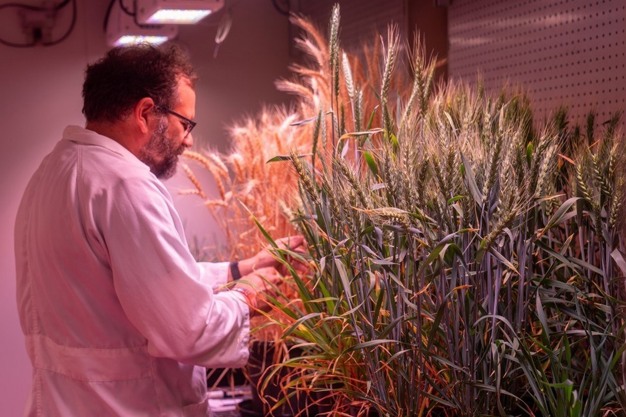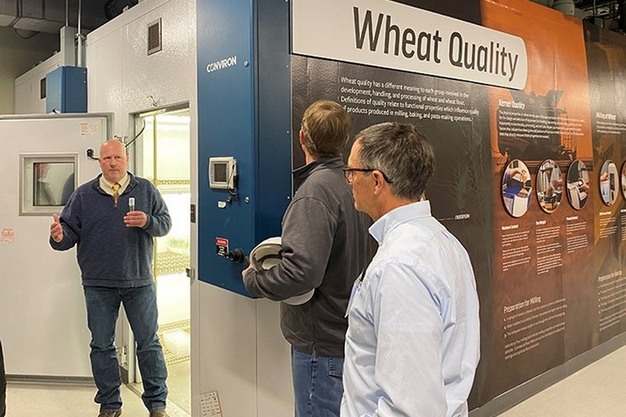Wheat belongs to the grass family (Poaceae) and is composed of wild and domesticated grasses many of which have spread across the globe. The two primary types of wheat consumed today are Triticum aestivum (common/bread) and Triticum turgidum (durum/pasta). T. aestivum is further subdivided between spring and winter wheats, the latter requiring a cold treatment (vernalization) and thus are sown in the fall. Wheat is described as a "mid-tall annual or winter annual grass with flat leaf blades and a terminal flower". However, domesticated wheats can now be described as a "short-mid" tall plant due to the green revolution whose goal was to feed the world. During the mid-20th century Norman Borlaug, Nobel Prize winner and father of the Green Revolution, introduced the newly bred wheat lines that were semi-dwarf and disease resistant which helped reduce global starvation.
Wheat is the most widely grown crop globally in terms of area and provides 20% of the world's food calories and protein. To keep pace with population growth wheat production needs to double by 2050. Continued genetic improvement of wheat is critical. In parallel with population growth, climate change is an added pressure for field crops. It is predicted to significantly reduce yields of the 'big three' (rice, maize and wheat) however wheat seems to be the most resilient. Periods of extreme heat, drought and waterlogging are problematic for wheat production as are new pests and diseases associated with local climate disturbances.
 © Conviron
© Conviron
Wheat research
The possibility of growing and breeding wheat in controlled environments was investigated by NASA at the University of Utah in the early 80s and their efforts resulted in a dwarf and tip-burn resistant wheat line (USU-Apogee) that can flower within 25 days when grown at 23°C under continuous light, PPFDs 510-930 μmol/m-2/s and 1000-1200 ppm CO2. While there isn't consensus yet with respect to intensity and spectrum, wheat does best when grown at 21-23°C day and 18-20°C night and high CO2 concentrations.
Breeding new lines of wheat in the field is a long process that can take over 12 years. In greenhouses 1-3 generations per year are typical, however in controlled environments breeding protocols continue to improve. The term speed breeding (SB) was coined in 2003 at the University of Queensland where SB techniques were developed that included spectrum optimization, light intensity, photoperiod and temperature to accelerate photosynthesis and time to flower even further (12). Speed breeding of wheat resulted in 4-6 generations per year when practiced in controlled environmental conditions that are conducive to rapid growth and early flowering, and this can be accelerated by combining SB with genetic selection (SpeedGS) where new lines were released in 7.5 years.
One SB Spring wheat protocol used an extended photoperiod of 22h (under HID or LED lights), PPFDs of 450-500 mmol/m2/s, day and night temperatures of 22°C and 17°C night, respectively and humidity levels of 60-70% to substantially reduce generation times. Winter wheat has a longer generation time than spring wheat due to the need for vernalization. Speed breeding protocols specific for winter wheat have been developed by combining vernalization duration, light intensity and photoperiod. Full generation times were on average under 100 days, compared to 128 days.
 © ConvironKansas Wheat CEO Justin Gilpin, far left, leads a tour of the Kansas Wheat Innovation Center.
© ConvironKansas Wheat CEO Justin Gilpin, far left, leads a tour of the Kansas Wheat Innovation Center.
Common research topics
There are a variety of wheat research topics that are crucial for ensuring food security and advancing agricultural practices, such as genetic and breeding, disease and pest management, abiotic stress tolerance, crop improvement, sustainable agriculture, and biotechnology.
Recommended plant growth chambers
Medium sized reach in chambers to large walk-in plant growth rooms are suitable for wheat research. Medium to large controlled environments can accommodate larger plant populations and more complex experiments. Two tier rooms are ideal for mass screening and sizeable plant propagation programs as they enable researchers to effectively grow twice as much wheat as compared to a single tier model of the same size. Mature wheat can range in height from 2' to 4' (60 cm to 120 cm).

Source: Conviron
For more information:
Conviron
www.conviron.com
